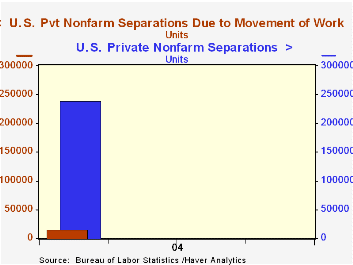 Global| Jun 11 2004
Global| Jun 11 2004Layoffs Associated with "Movement of Work": New BLS Series
Summary
New data from the BLS show that roughly 10% of companies' extended mass layoffs during the first quarter of 2004 were associated with the movement of work. Of 1,204 so-called layoff "events", 119 were connected to relocations and one- [...]

New data from the BLS show that roughly 10% of companies' extended mass layoffs during the first quarter of 2004 were associated with the movement of work. Of 1,204 so-called layoff "events", 119 were connected to relocations and one-third of those involved overseas sites. These actions caused a total 239,361 workers to lose their jobs for more than 30 days (the BLS threshold for an "extended" layoff), including 16,021 in the relocation situations. Of these, 4,633 jobs represented the reassignment of the work outside the United States.
These new data on relocation-related layoffs are presently being added to Haver's USECON and REGIONAL databases. Data for total layoffs by Census region are available now in the REGIONAL database. Watch for detailed breakdowns by industry and "reason" at the national level early next week in USECON. Mass layoffs are defined to include the separations of at least 50 people. The layoff event numbers are taken from unemployment insurance records. They are, then, NOT a sample survey, but an actual count. BLS analysts contact every company that implements a layoff event to ask about the total number of people separated and the reasons for the separation; the BLS reported that 7.2% of the firms refused to answer its questions, and others may have given incomplete responses. There is thus nonsampling error in the data, but no loss of quality due to sampling issues.
The data show that in the first quarter of 2004, 65% of the separations due to the movement of work occurred in the manufacturing industries. This is disproportionate compared with the mere 24% of all mass layoffs that came in manufacturing. In the information industry, only 1,449 workers lost jobs due to movement of the work. This constitutes about 9% of all layoffs associated with relocation and about 18.5% of all layoffs in the information industry.
Motivations for layoffs related to the shift of work to new sites included financial difficulty, 15%, and internal reorganizations, 55%. Total layoffs during the first quarter were, by contrast, heavily concentrated in seasonal work and the completion of outstanding projects, absorbing 21% and 24%, respectively of the total. Financial difficulty and bankruptcy generated only 10% of total layoffs and reorganizations, 11%.
These new data on layoffs associated with the movement of work are likely to be quite interesting. For instance, the numbers in the information industry seem low, compared with widely publicized shifts of customer support operations to other countries. It is thus important that the total figures represent hard information from administrative records, and not opinion surveys or anecdotes.
| Q1 2004, Number | Layoff Events | Workers Separated from Their Jobs|||||
|---|---|---|---|---|---|---|
| Total | Selected Industries | Selected Reasons | ||||
| Manufacturing | Information | Financial Difficulty | Internal Reorganization | |||
| Total Private Nonfarm | 1,204 | 239,361 | 57,616 | 7,837 | 15,755 | 26,982 |
| Associated with Movement of Work | 113 | 16,021 | 10,438 | 1,449 | 2,394 | 8,736 |
| Overseas | 34 | 4,633 | -- | -- | -- | -- |
| Domestic | 79 | 9,985 | -- | -- | -- | -- |
Carol Stone, CBE
AuthorMore in Author Profile »Carol Stone, CBE came to Haver Analytics in 2003 following more than 35 years as a financial market economist at major Wall Street financial institutions, most especially Merrill Lynch and Nomura Securities. She had broad experience in analysis and forecasting of flow-of-funds accounts, the federal budget and Federal Reserve operations. At Nomura Securities, among other duties, she developed various indicator forecasting tools and edited a daily global publication produced in London and New York for readers in Tokyo. At Haver Analytics, Carol was a member of the Research Department, aiding database managers with research and documentation efforts, as well as posting commentary on select economic reports. In addition, she conducted Ways-of-the-World, a blog on economic issues for an Episcopal-Church-affiliated website, The Geranium Farm. During her career, Carol served as an officer of the Money Marketeers and the Downtown Economists Club. She had a PhD from NYU's Stern School of Business. She lived in Brooklyn, New York, and had a weekend home on Long Island.





